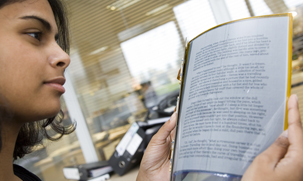Screen technology
Description
Since the first printing technology of movable type was created in China by Bisheng out of baked clay, “book” emerged as a way to spread knowledge and information. Along the history, the printing technology always plays an important role in the development of book industry or publishing industry.
The saying of “book is doomed” is based on the assumption of screen technologies would develop as printer technologies had and even outdo the printer technology one day. We can imagine that the books will experience a dramatic change the moment screen technology improves enough to compete with the printed page. It is reported that during the last several years, more and more books are printed in digital ink. Some screen technologies can be the supporting key technology for the future books, for example, the touch-screen technology, screen with flexibility.
Enablers
- PDA and Cell-Phone Industries are making these screens (touch-screen technology) more useable and drive the technology to develop.
- Modern electronic technology
- Display manufacturers and System On Chip (SOC) manufacturers worldwide acknowledged the trend toward acceptance of touch-screens as a highly desirable user interface component
Inhibitors
- Pressure and stress by touching on screens makes screens non-flexible and fragile.
Paradigms
- The touch-screen zooming interface is the key to the next generation of "books." It allows users to move into 3D networked space easily and fluently and it gets us beyond the linearity that is the hallmark and the limitation of the paper book. The future networked book is going to require three-dimensional visualizations for both content and navigation. This technology is presented at TED (Technology Entertainment Design) held at February 2006 by Jefferson Y. Han.link see here
- Plastic Logic is the outstanding leader in plastic electronics manufacturing, a revolutionary new technology for printing electronic devices. The company will be the first to apply the new technology to a fully commercial application: flexible active-matrix displays. Plastic Logic is building the first commercial manufacturing facility targeted at flexible active-matrix display modules for ‘take anywhere, read anywhere’ electronic reader products. It will utilize Plastic Logic’s unique process to fabricate active-matrix backplanes on plastic substrates which, when combined with an electronic-paper frontplane material, will be used to create display modules that are thin light and robust. This will enable a digital reading experience that is much closer to paper than any other technology.
Experts
Jefferson Y. Han, a research scientist for New York University's (NYU) Courant Institute of Mathematical Sciences.
Timing
- The HP-150 from 1983 was the world's earliest commercial touch screen computer
- The development of multipoint touch-screens facilitated the tracking of more than one finger on the screen. Operations that are only possible with more than one finger are possible, as demonstrated with the Apple iPhone, in 2006
Web Resources
<pagerating from="Poor" to="Good" category="Scenario"> Rate this page</pagerating>
